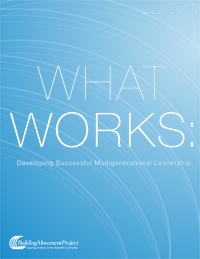What Works: Developing Successful Multigenerational Leadership
Since the start of the 2000s, there has been growing concern about the breadth and depth of new leadership in the nonprofit sector. For the most part, the alarm was focused on the departure of the Baby Boomer generation, those born between 1946 and 1965. This large cohort – so key to the development and growth of nonprofit organizations – was reaching the traditional age of retirement and there was fear that there were too few leaders in the next generations to take their place. But this expectation of a mass exodus has given way to a new reality. The changing economic climate, extended life expectancy, and the desire to be remain active and continue their contributions are leading Boomers to remain in the workforce for a longer period of time.
This changing narrative of nonprofit leadership presents a new challenge. Leadership and workforce development are still top priorities for the nonprofit sector, but older workers continue to be a powerful presence. At the same time, younger generations and for-profit professionals are entering the sector in increasing numbers. With up to four generations at work, nonprofit leaders are now struggling to make room for the ideas and skills of newer generations, while figuring out how to support the continued presence of older, more seasoned workers.
The What Works study looks at the key factors that build leadership and commitment across generations. While it is true that generations differ in how they approach their work, there are remarkable similarities in what people want out of their work and workplaces. Rather than focus on well-documented differences, What Works examines what helps potential leaders do their best work, what constitutes a good workplace, and how to improve on our ability to retain, support, and promote staff across generations. This report—a collaboration between the Building Movement Project and Idealist.org—offers a roadmap for how nonprofits can create dedicated staff, build their capacity to lead, and deepen their commitment to the nonprofit sector at little to no cost.
This work was generously funded in part by American Express Foundation.

